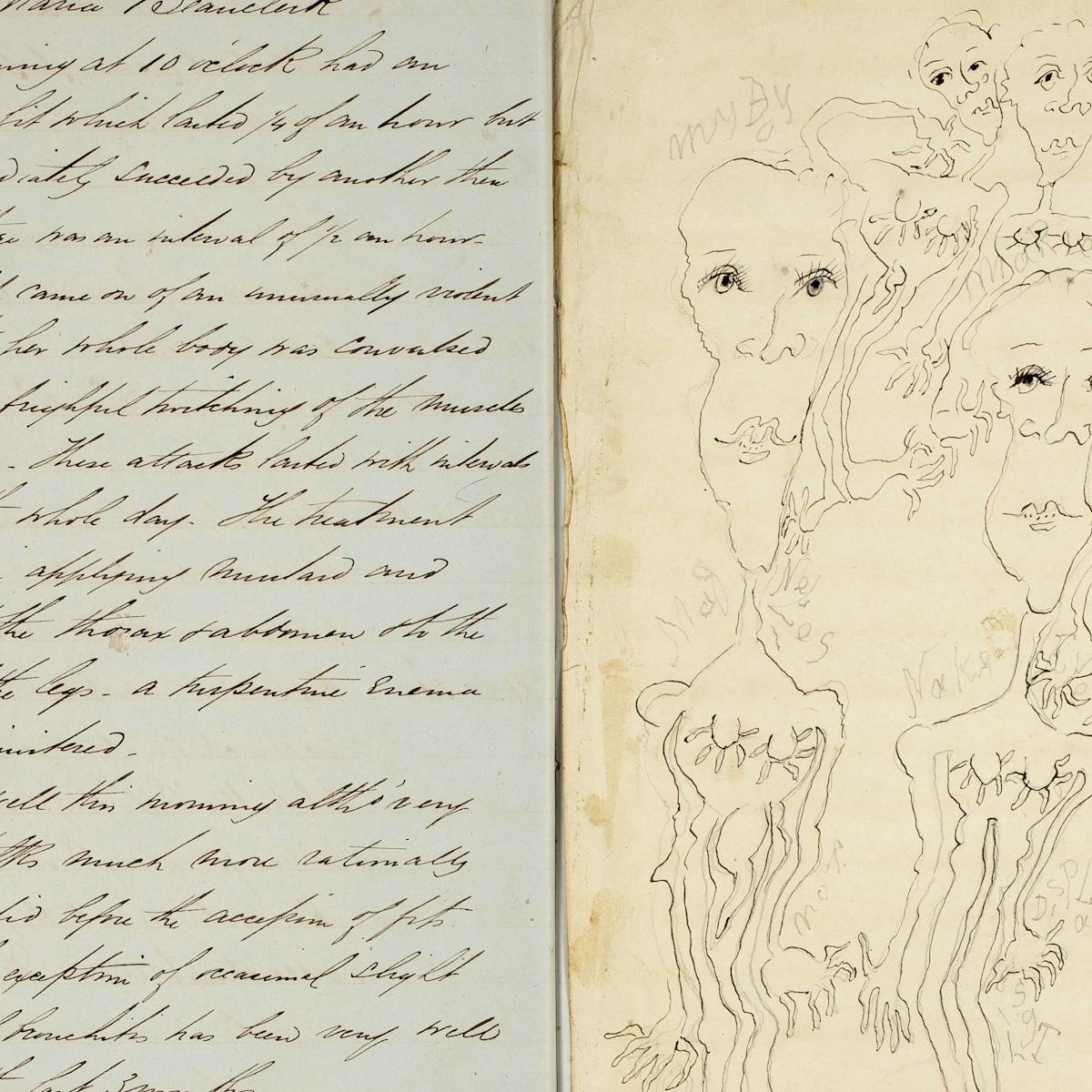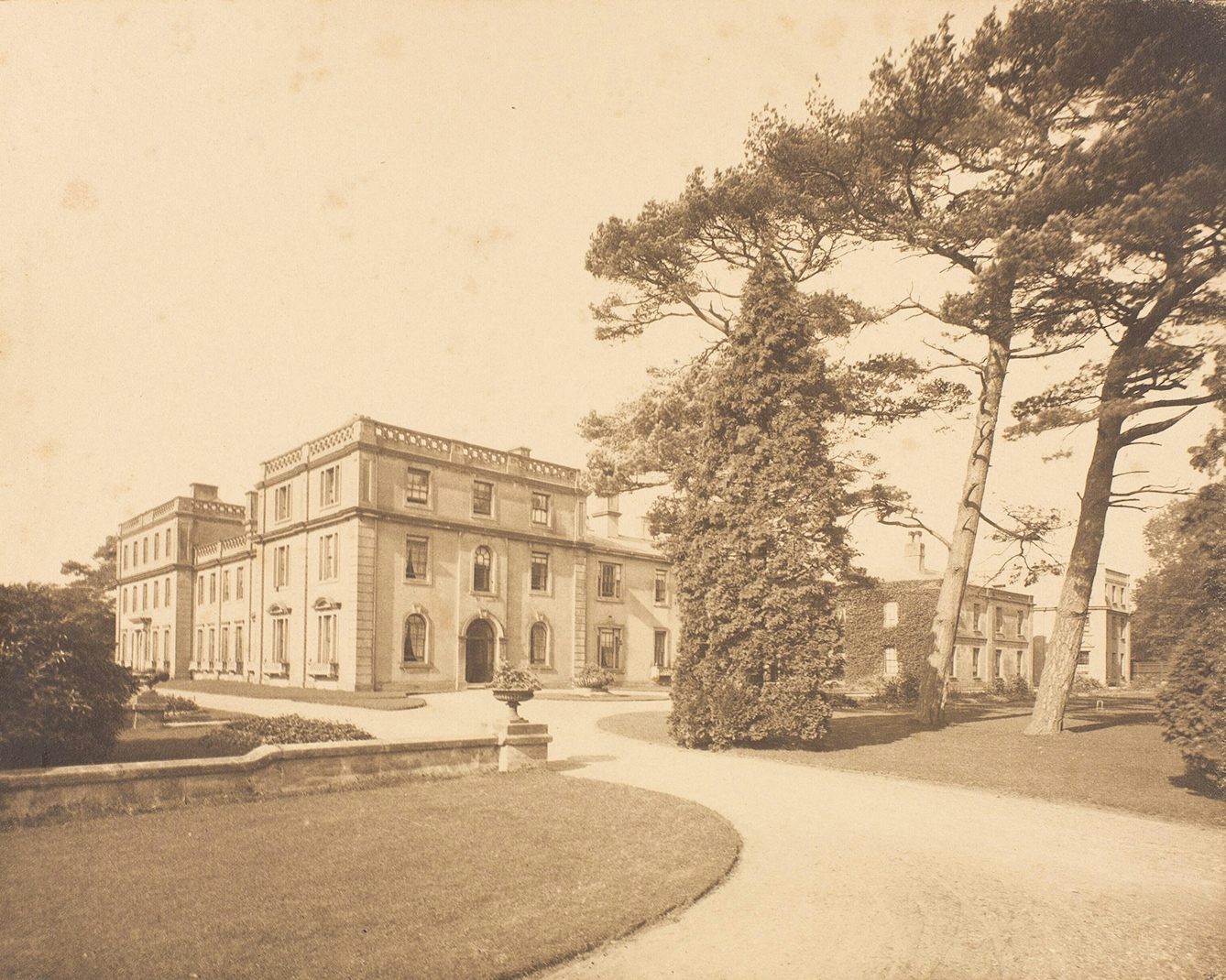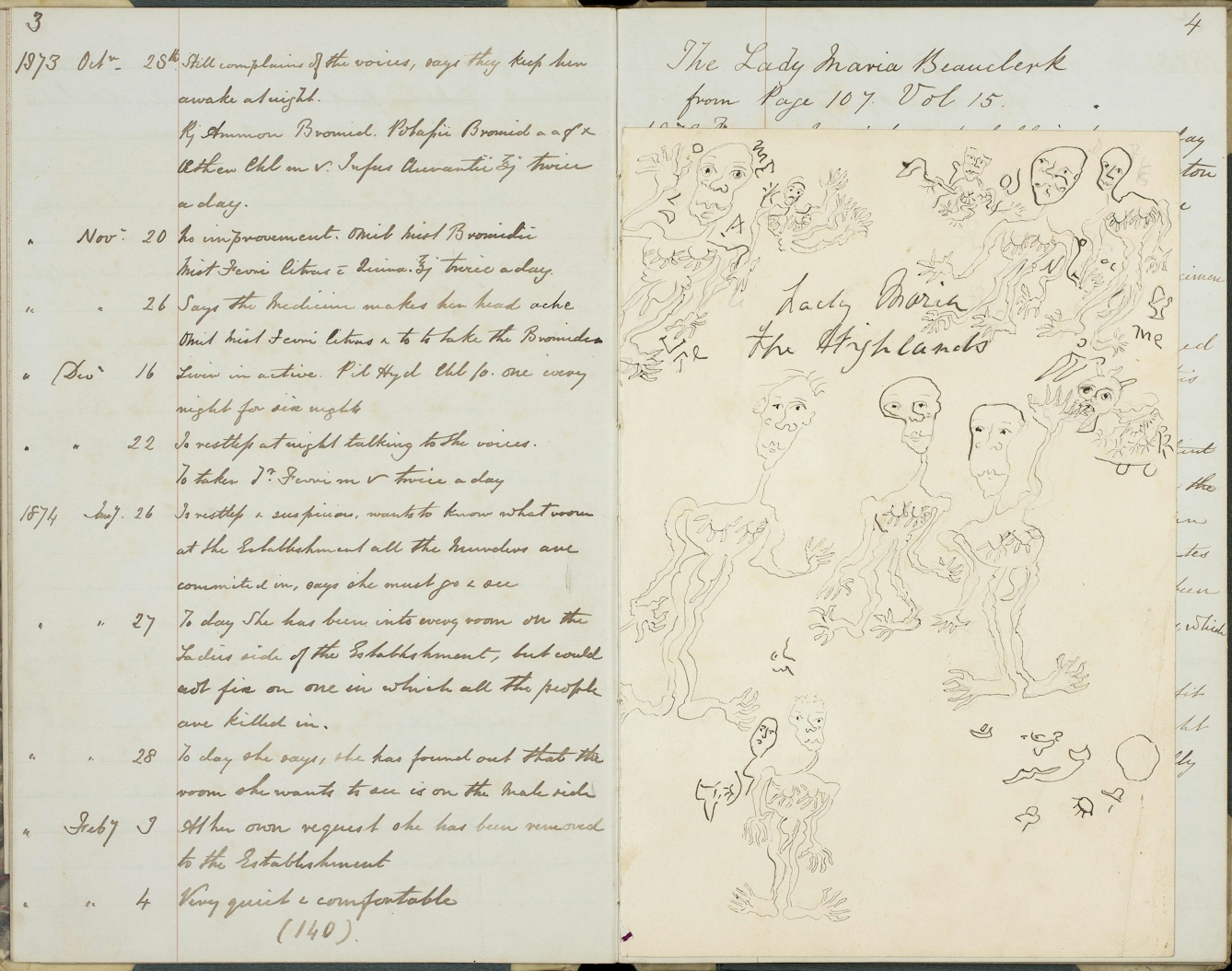Dementia is a fear-laden concept that’s increasingly ubiquitous in the 21st century. But how has its meaning changed? And how was it understood and experienced in the past, especially by women?
Uncovering experiences of dementia
Millie van der Byl Williamsaverage reading time 7 minutes
- Article
In the UK today, dementia – and dementia care – disproportionately affects women. As part of Created Out of Mind, I’ve been delving into the 19th-century records of a private asylum to uncover the hidden stories of some of its women patients, 150 years after they were diagnosed with dementia.
Finding our women
Ticehurst House Asylum in East Sussex was a mixed-sex, elite establishment attracting some of the wealthiest patients in Victorian society. I’ve ‘met’ three especially intriguing women on my journey through the asylum’s archives – one a lady and an artist, one who had been living with prostitutes and was said to resemble Queen Victoria, and one who was close to her family but was plagued by terrible fear.
Although the Ticehurst casebooks mostly concentrate on objective information, the strong personalities of Lady Maria Beauclerk, Ann Beacon and Mary Willet stood out. The more I read about them, the more fascinated I became.
All three resided at the private asylum between 1850 and 1900, and all had a diagnosis of dementia. But dementia meant something quite different in the 19th century from what it does today. The definition also varied depending on the institution and the doctor diagnosing the individual. Broadly, it was understood as an intellectual deficit that was acquired. Its causes were often undefined and it could be diagnosed at any age.
What dementia meant for each woman at Ticehurst was different: Lady Maria’s dementia was caused by a “disappointment of the affections”, Ann’s “Dementia chronic” was “hereditary?”, and the cause of Mary’s “Senile Dementia” was “old age”.
Ticehurst House Asylum was an elite establishment attracting some of Victorian society’s wealthiest patients.
The mischievous Lady Maria
Lady Maria Beauclerk’s artwork was included with her case notes.
Lady Maria Beauclerk entered Ticehurst when she was 51 with a diagnosis of dementia, and died there aged 73. Maria was the daughter of a duke. She wasn’t the only member of her family in the asylum; her brother was also at Ticehurst, while other family members were said to be in a “similar state”. This is particularly interesting because of an obsession at the time with the idea that madness was an “hereditary taint”.
Maria’s case notes state that “this lady is in a state of ‘dementia’, unconnected and imperfectly defined ideas chase each other rapidly through her mind… her power of continued attention and reflection are lost”.
She’s also described as “mischievous”, “gay”, “perverse” and “peevish”, with a tendency to have “occasional attacks of excitement” in which she would exclaim, “We are all mad, O God!”
However, for much of her stay at Ticehurst, Lady Maria was said to be “tranquil”, “smiling and sportive”. Most of the entries into her casebooks state that her condition is “precisely the same”. The more I learned about her, the clearer it became that Lady Maria’s dementia shared very few characteristics with the modern-day concept, apart from the emphasis on the chronic nature of her condition.
What I found most interesting about Lady Maria was her artwork, which was included with her case notes. Her intricate sketches feature repeated figures with words jumbled up around them. Samuel Newington, the owner of the asylum, reported that Maria often “employed herself” by drawing and cutting paper, as well as “working with patches of cloth, wool, etc.”.
Keeping these artworks with the case notes was likely motivated by a desire to prove the ‘insanity’ of Lady Maria, rather than any appreciation of the art itself. Her sketches are even described as “grotesque”. Despite this, Lady Maria’s work is a striking expression of her experiences and inner thoughts.
The indolent Ann Beacon
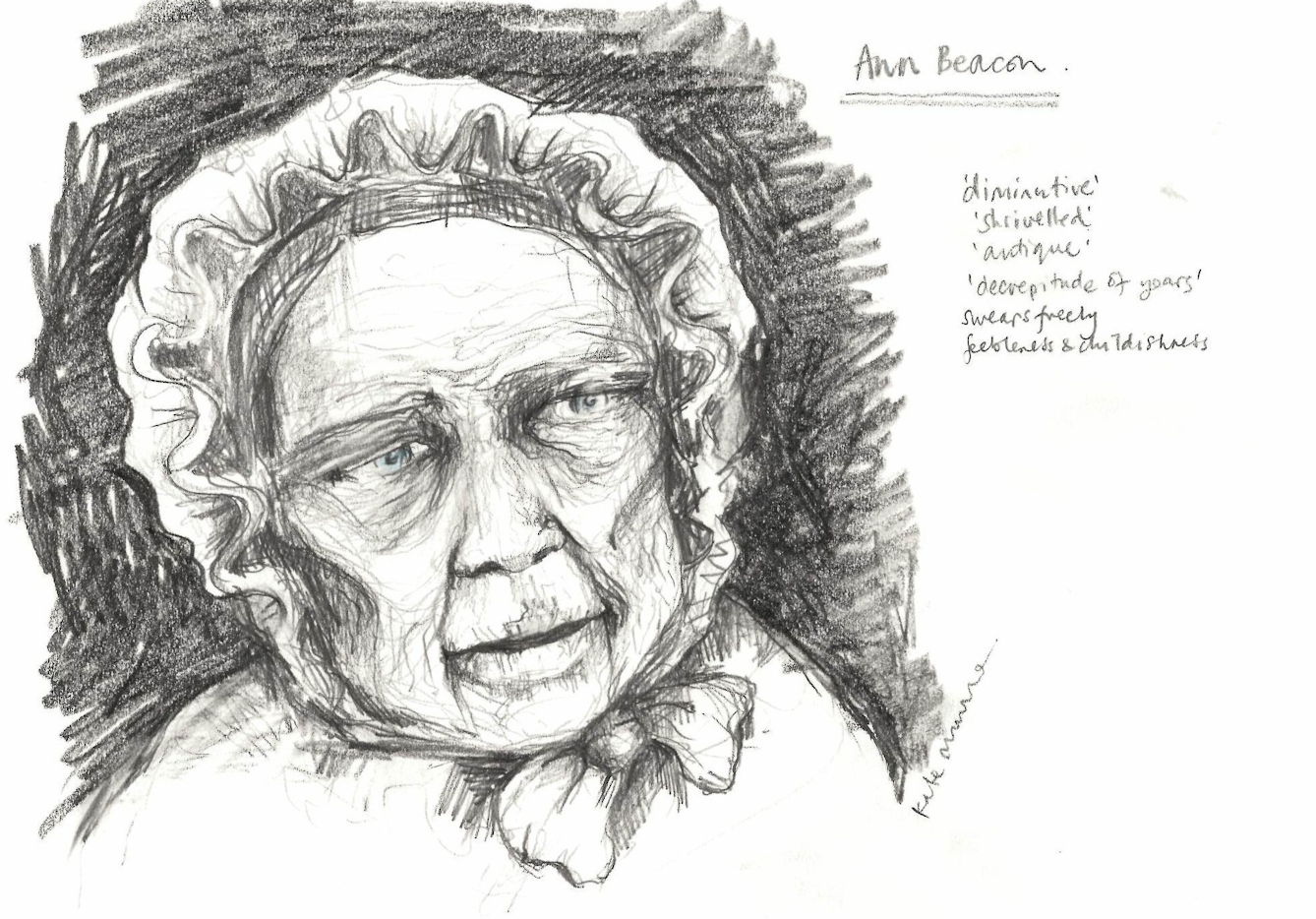
An artist’s impression of what Ann Beacon might have looked like.
Although the asylum attendants may not have approved of how Lady Maria kept herself busy, they were equally critical of the idleness of other patients, such as Ann Beacon – who had apparently “always been an indolent person”.
Ann entered the asylum aged 81 and died there seven years later. Her dementia was also thought to be hereditary. She was reported to have been living in a state of “filth and abandonment” on the Isle of Sheppey in the company of prostitutes, where she was found to be a “lunatic” and was later diagnosed with “Dementia chronic”. The inclusion of the word ‘chronic’ in Ann’s diagnosis indicates that she was not expected to recover.
Ann’s case notes present some features that we would recognise from a modern diagnosis of dementia: her “memory and understanding [are] much impaired”, “she cannot remember names”, and “she is over 80 years old and yet says she is only 28”.
Ann’s personality permeates her case notes. We hear of her anecdotes of the queen (and that people tell her she resembles the queen), that she pretends to say grace in French, and that she repeats comic verses. The case notes also report that Ann is “fond of the male sex”, she reportedly could no longer remember the number of husbands she had, and “manifests a good deal of assertiveness when in the company of gentlemen”.
What perplexes us most concerning Ann is how she could afford to stay in the most elite asylum in England. After all, only a few months before, she had been living in extremely poor conditions. There’s clearly much more in her story to uncover.
The melancholy Mary Willet
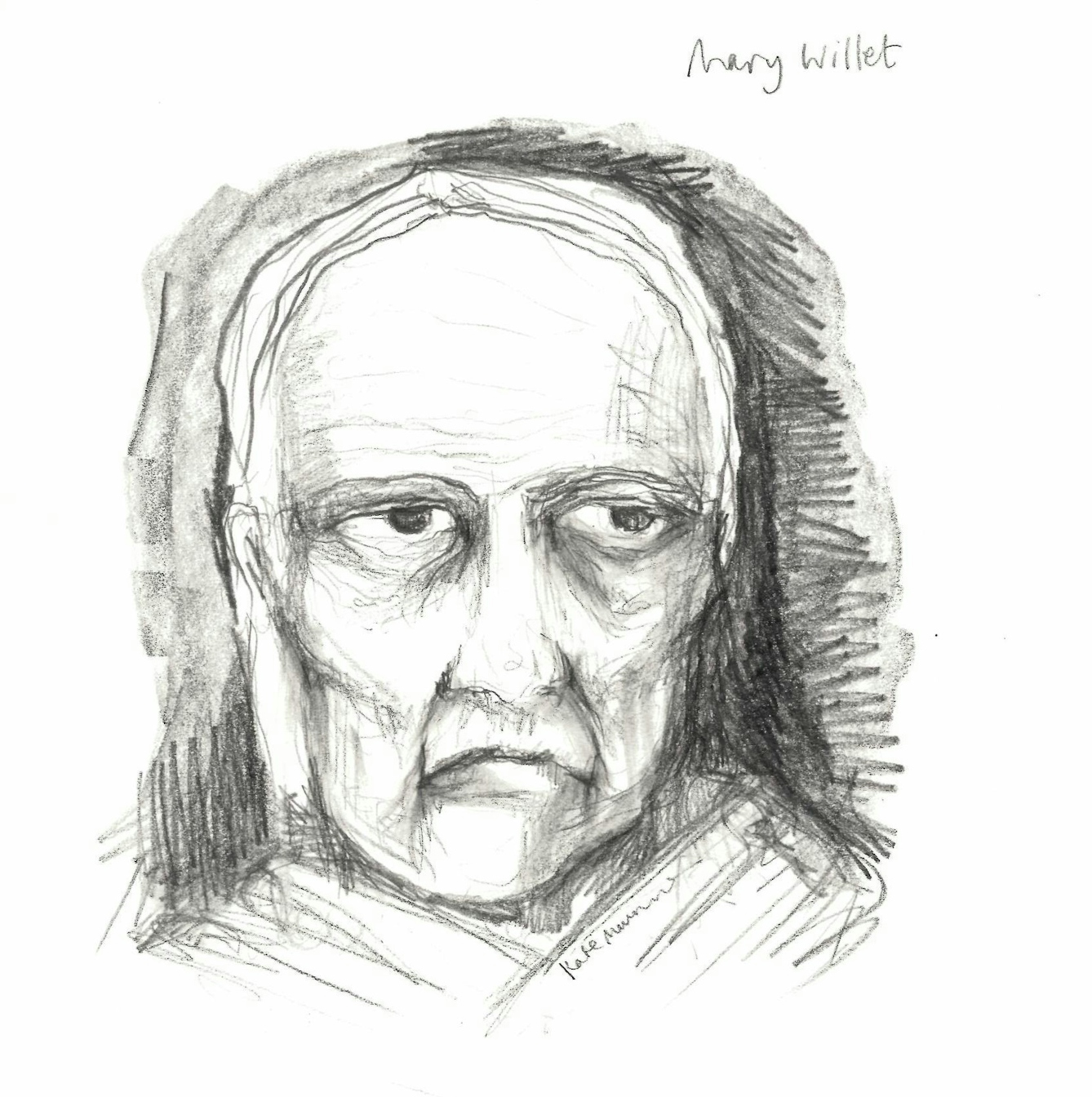
An artist’s impression of what Mary Willet might have looked like.
Of our three women, Mary was closest to her family and friends. She entered the asylum when she was 78 and died there aged 92 from “senile decay”. Unlike our other two women, Mary’s condition is much more strongly linked to her age. Her case notes state she is “evidently the subject of senile dementia… perfectly irrational in all she says”.
But Mary’s case is far from ordinary; she is “full of delusions” that she has grievously wronged others, and suffers with “melancholia” and “hysteria”. It is particularly interesting that, despite such a confident diagnosis of senile dementia (which we would assume to be close to our understanding of dementia today), Mary’s symptoms seem very different from what we would expect. She is plagued by terrifying delusions that she will undergo “terrible punishment” by the Lord and that she will be “devoured by wild beasts”.
Despite this, Mary retains relationships with her extended family and friends. Her family often come and stay in the neighbourhood, visiting her every day. Their observations are also recorded in her case notes, for example: “Her nieces came to see her, they found her much improved” and that her daughter “never saw her mother looking so well”.
The case notes document her improvement in health by noting that she occupies herself more, reading the Bible a great deal, going on walks, and writing to her friends, family and her children in India.
Towards the end of Mary’s time at Ticehurst, she is reported to have repeatedly asked her doctors, “Do you think I shall live till the morning?” Otherwise, the focus of her case notes is mainly on her bodily condition, and efforts to keep her healthy despite her “advanced age”.
Uncovering and connecting
The experience of going through Maria, Ann and Mary’s case notes was emotional as well as academic.
Maria, Ann and Mary’s stories provide a glimpse of the very different understandings of dementia in this period. There are some notable overlaps, both between the three women and our modern understanding of dementia.
Both Ann and Mary are reported to have problems with their memory (although Ann much more so). All three of them have difficulties with comprehension, reflection and understanding, and all are viewed as chronic cases. The women also demonstrate how a diagnosis of dementia could span different ages, social classes, and symptoms. However, perhaps more importantly, their case notes also reveal the journeys these very different women had, united by a shared diagnosis and a stay in the most elite asylum in the country.
Their stories were hidden away for so many years, and it has been a privilege to begin to uncover and share what happened to them. The connection I now feel with them was totally unexpected. Ultimately, the experience of going through their case notes was not just an academic exercise but also a profoundly emotional journey.
All the materials from Ticehurst Asylum that feature in this article are kept at Wellcome Collection and have now been digitised. Created Out of Mind is exploring and challenging our understanding of dementias through science and the creative arts.
About the contributors
Millie van der Byl Williams
Millie is a research assistant at Created Out of Mind. She has a background in philosophy, and her current work includes looking at historical representations of dementia and studying co-creativity with people with dementias.
